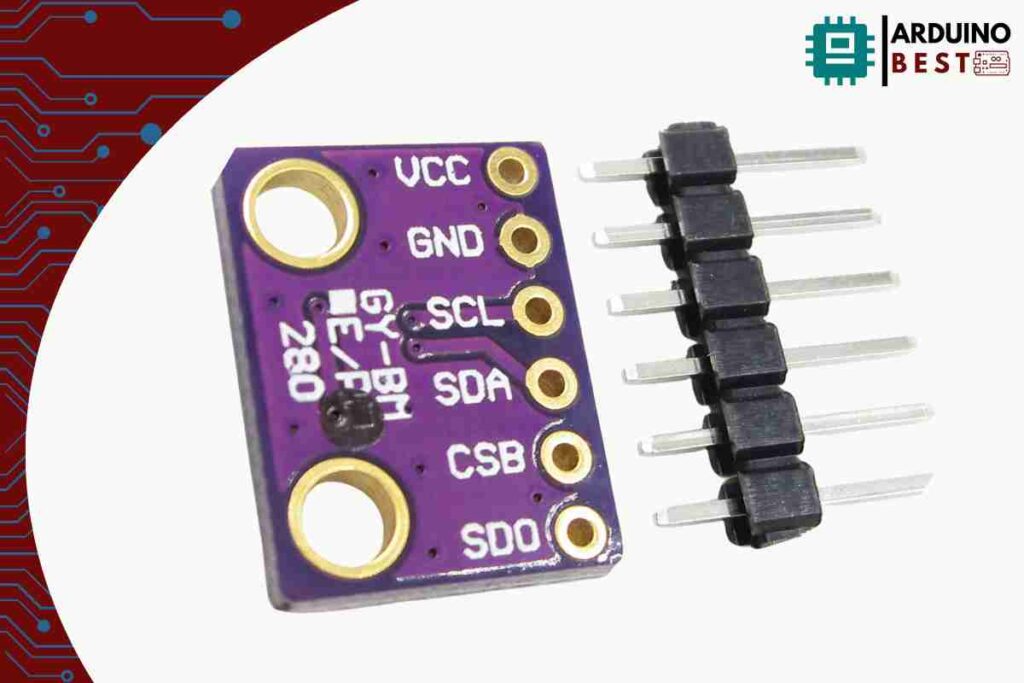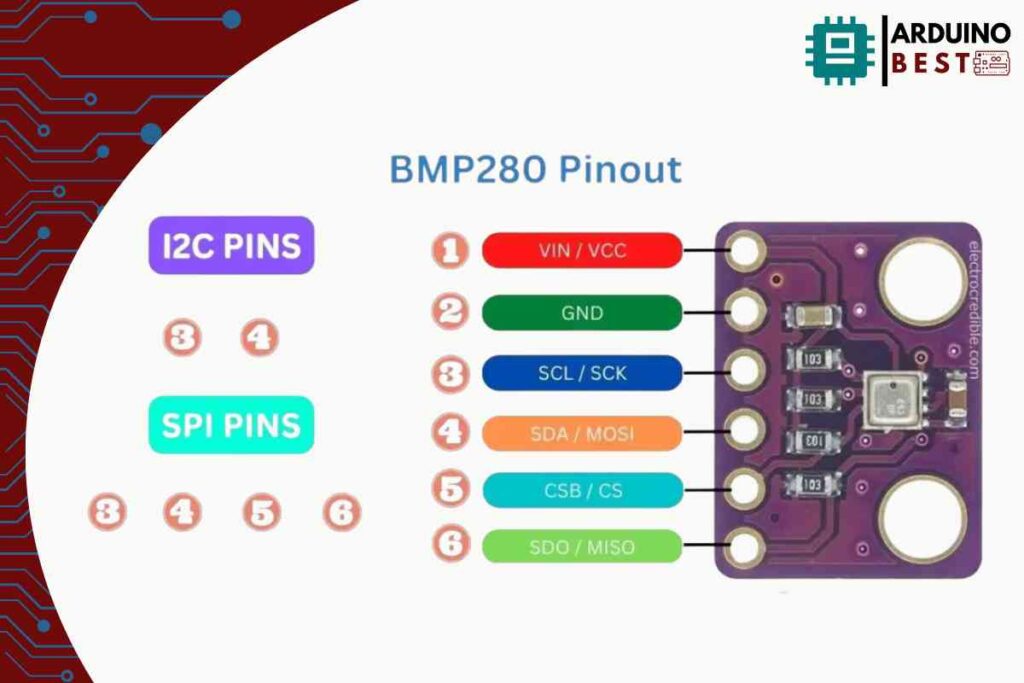Introduction
Table of Contents
Environmental sensors play a crucial role in modern applications, from weather monitoring to altitude tracking. One of the most widely used sensors in this domain is the BMP280 – Barometric Pressure and Temperature Sensor. Developed by Bosch Sensortec, this compact and efficient sensor provides precise measurements for pressure and temperature, making it ideal for various industries.

BMP280 – Barometric Pressure and Temperature Sensor, With applications in GPS navigation, wearables, and weather stations, the BMP280 is a favorite among developers and engineers. Whether you’re integrating it into an IoT system or a mobile application, understanding its capabilities will help you make the most out of this versatile component.

Background of BMP280 Sensor
The BMP280 sensor is an upgrade from its predecessors, such as the BMP085 and BMP180. Bosch Sensortec improved its performance by enhancing accuracy, reducing power consumption, and offering a more compact form factor. It is widely used in:
- Meteorological applications for weather forecasting
- Altitude measurement for drones and aviation
- Fitness tracking for monitoring elevation changes
For a deep dive into sensor technology advancements, check out Bosch Sensortec’s official documentation on the BMP280 sensor.
Technical Specifications
The BMP280 sensor boasts impressive specifications that make it a reliable choice for high-precision applications. Below are its key features:
- Pressure Range: 300 to 1100 hPa
- Temperature Range: -40°C to 85°C
- Pressure Accuracy: ±1 hPa
- Temperature Accuracy: ±1.0°C
- Resolution:
- Pressure: 0.01 hPa
- Temperature: 0.01°C
- Power Consumption: 3.4 µA at 1 Hz
- Interfaces: Supports I²C (up to 3.4 MHz) and SPI (up to 10 MHz)
- Compact Size: 2.0 x 2.5 x 0.95 mm³
Features and Benefits
The BMP280 sensor comes with multiple advantages, making it suitable for various embedded applications:
- High Precision: Offers accurate pressure and temperature readings
- Low Power Consumption: Ideal for battery-powered projects
- Compact Design: Easy to integrate into small devices
- Dual Interface Support: Works with both I²C and SPI
- Robust and Reliable: Can operate in a wide range of environmental conditions
For more details on integrating this sensor into microcontroller-based systems, refer to Adafruit’s BMP280 sensor guide.
Applications of BMP280 Sensor
The BMP280 is used in various domains, thanks to its versatility and precision:
- Weather Monitoring: Helps track atmospheric pressure trends
- Altitude Measurement: Used in GPS devices for elevation correction
- Fitness Wearables: Tracks elevation changes in smartwatches and fitness trackers
- Drone Navigation: Helps stabilize flight by measuring altitude
- Home Automation: Enhances smart home systems with environmental sensing
Interfacing BMP280 with Microcontrollers
The BMP280 sensor can be easily interfaced with microcontrollers like Arduino, Raspberry Pi, and ESP32. Below are the wiring configurations:
Using I²C
- VCC → 3.3V (or 5V with level shifter)
- GND → Ground
- SCL → SCL pin on microcontroller
- SDA → SDA pin on microcontroller
Using SPI
- VCC → 3.3V
- GND → Ground
- SCK → SPI Clock (SCK)
- SDO → MISO (Master In Slave Out)
- SDI → MOSI (Master Out Slave In)
- CS → Chip Select
Programming and Libraries
Several libraries make it easier to interface the BMP280 sensor with popular microcontrollers:
- Adafruit BMP280 Library (for Arduino)
- SparkFun BMP280 Library
- Python Libraries for Raspberry Pi (via
smbusorAdafruit_CircuitPython_BMP280)
Example Code (Arduino – I²C)
#include <Wire.h>
#include <Adafruit_BMP280.h>
Adafruit_BMP280 bmp;
void setup() {
Serial.begin(115200);
if (!bmp.begin()) {
Serial.println("Could not find BMP280 sensor!");
while (1);
}
}
void loop() {
Serial.print("Temperature = ");
Serial.print(bmp.readTemperature());
Serial.println(" *C");
delay(2000);
}Calibration and Accuracy Optimization
To ensure the BMP280 sensor provides accurate readings:
- Use proper power supply (stable 3.3V or 5V with a level shifter)
- Allow warm-up time for sensor stabilization
- Perform software calibration using offsets based on environmental conditions
Troubleshooting Common Issues
- Sensor Not Detected: Check wiring and address conflicts on I²C
- Inaccurate Readings: Ensure stable voltage supply and recalibrate
- Communication Errors: Use appropriate pull-up resistors for I²C lines
FAQs
What is the difference between BMP280 and BME280?
The BME280 includes a humidity sensor, while the BMP280 only measures pressure and temperature.
Can BMP280 measure humidity?
No, the BMP280 sensor does not support humidity measurement.
How do I interface BMP280 with an Arduino?
You can use I²C or SPI communication and libraries like Adafruit BMP280 to interface the sensor.
How accurate is the BMP280?
It has a pressure accuracy of ±1 hPa and a temperature accuracy of ±1.0°C.
Can BMP280 be used for altitude measurement?
Yes, it calculates altitude using pressure differences, making it useful for GPS applications.
Conclusion
The BMP280 – Barometric Pressure and Temperature Sensor is a versatile and efficient component widely used in environmental monitoring, altitude tracking, and IoT applications. Its high precision, low power consumption, and compact design make it an excellent choice for various embedded systems. Whether you’re a hobbyist or a professional, the BMP280 is an invaluable tool for accurate pressure and temperature measurement.
Here we suggest other projects:
1- Complete Guide for DHT11/DHT22 Humidity and Temperature Sensor With Arduino
2- DHT11 – Temperature and Humidity Sensor
3- DHT22 – Temperature and Humidity Sensor (more accurate than DHT11)

